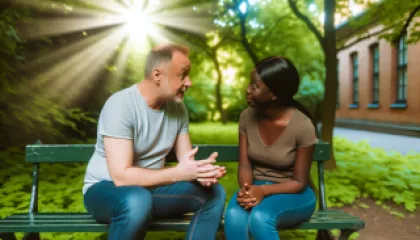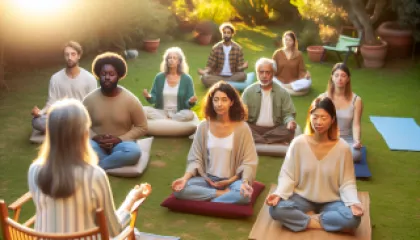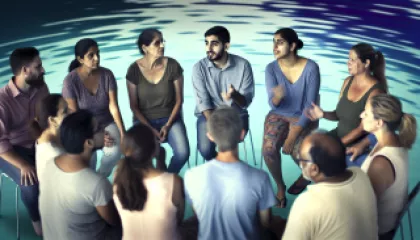Why Online Therapy for Clutter Issues is Essential for Emotional Well-being
The Overlooked Link Between Clutter and Emotional Well-being
In a world where we are constantly bombarded with stimuli, it's easy to overlook the seemingly benign aspects of our lives that might be contributing to our stress levels. One such overlooked aspect is clutter. While many might only see clutter as a physical nuisance, its impact on emotional well-being is profound and often underestimated.
Clutter isn't just about having too many things; it represents unmade decisions and postponed tasks. These small, seemingly insignificant piles of papers, unused gadgets, and unworn clothes can have a surprisingly strong impact on our mental health. The link between mental health and organization is well documented, yet often ignored in day-to-day life.
Why Clutter Causes Emotional Distress
Clutter can affect us in several ways:
- Overstimulation: Our brains are wired to respond to stimuli in our environment. When surrounded by clutter, our senses become overloaded, leading to feelings of stress and anxiety.
- Distraction: Clutter can make it difficult to focus. This lack of focus can lead to decreased productivity and an increase in procrastination, further exacerbating stress.
- Guilt: Seeing clutter can remind us of tasks we've left undone, creating a sense of guilt and inadequacy.
- Embarrassment: A cluttered home or workspace can be a source of embarrassment, leading to social isolation and decreased self-esteem.
These emotional burdens can accumulate over time, significantly impacting our overall mental health. It's no wonder that many people seek online therapy for clutter issues to help manage these feelings.
The Benefits of Online Therapy for Clutter Issues
Traditional therapy has long been a resource for those struggling with mental health issues, but the rise of online therapy has made it more accessible than ever. Here are some reasons why online therapy is particularly effective for dealing with clutter-related emotional distress:
- Accessibility: Online therapy can be accessed from anywhere, making it easier for individuals to seek help without the barriers of distance or transportation.
- Convenience: Scheduling appointments online offers greater flexibility, allowing individuals to fit therapy sessions into their busy lives more easily.
- Anonymity: For those who feel embarrassed or ashamed about their clutter, online therapy provides a level of anonymity that can make it easier to open up about their struggles.
- Specialized Support: Many online therapy platforms offer specialized support for specific issues, including emotional clutter support online. This means individuals can find therapists who are specifically trained to help with clutter-related challenges.
The Psychological Impact of Clutter
To understand why organizing for mental clarity is so crucial, it's important to delve deeper into the psychological impact of clutter. Research has shown that clutter can lead to:
- Increased Stress Hormones: Studies have found that living in a cluttered environment can increase levels of cortisol, a stress hormone. Elevated cortisol levels can lead to a variety of health issues, including anxiety, depression, and even heart disease.
- Decreased Productivity: A cluttered space can make it difficult to focus on tasks, leading to decreased productivity and increased feelings of frustration and overwhelm.
- Impaired Cognitive Function: Clutter can negatively impact our cognitive abilities, making it harder to think clearly and process information efficiently.
Given these significant impacts, it's clear that addressing clutter is not just about tidying up—it's about improving our mental health and overall quality of life.
Case Study: Penelope Dunn's Journey to Decluttering
Take the example of Penelope Dunn, a working mother of two who struggled with clutter for years. Penelope found herself constantly stressed and overwhelmed, unable to keep up with the demands of her job and family life. She realized that her cluttered home was contributing to her feelings of anxiety and sought out online support for clutter issues.
"I never realized how much my clutter was affecting my mental health until I started working with an online therapist. They helped me understand the emotional roots of my clutter and gave me practical tools to start decluttering my space and my mind."Penelope Dunn
Through online therapy, Penelope was able to tackle her clutter and, in turn, improve her emotional well-being. Her story is a testament to the power of online therapy in addressing the often-overlooked issue of clutter.
Decluttering Strategies for Mental Clarity
For those struggling with clutter, here are some strategies that can help:
- Start Small: Tackle one small area at a time, such as a single drawer or shelf. This can make the task feel more manageable and less overwhelming.
- Set Goals: Set specific, achievable goals for your decluttering efforts. This can help you stay motivated and track your progress.
- Get Rid of Duplicates: Identify items you have multiples of and decide which ones you can let go of. This can quickly reduce the amount of clutter in your space.
- Create Systems: Develop systems for organizing items in a way that makes sense to you. This can help prevent clutter from accumulating in the future.
- Seek Support: Don't be afraid to seek help, whether from friends, family, or a professional therapist. Having support can make the process easier and more effective.
The Role of Emotional Support in Decluttering
Decluttering isn't just a physical task—it's an emotional journey. Many people find that their clutter is tied to deeper emotional issues, such as grief, guilt, or attachment. This is where emotional clutter support online can be incredibly beneficial.
Online therapy provides a safe space to explore the emotional roots of clutter and develop strategies for letting go. It also offers ongoing support, helping individuals stay motivated and accountable as they work towards a clutter-free life.
The Connection Between Clutter and Self-Identity
Clutter can also impact our sense of self and identity. For many people, their possessions are tied to their memories, aspirations, and sense of self-worth. Letting go of clutter can feel like letting go of a part of themselves.
However, decluttering can also be an opportunity to redefine oneself and create a living space that truly reflects who you are and what you value. By working with a therapist, individuals can navigate this complex emotional terrain and emerge with a clearer sense of self.
Final Thoughts on the Importance of Decluttering for Emotional Well-being
In conclusion, the impact of clutter on our emotional well-being is profound and multifaceted. From increasing stress levels to impairing cognitive function, clutter can take a significant toll on our mental health. However, by seeking online therapy for clutter issues, individuals can receive the support they need to address this often-overlooked aspect of their lives.
Online therapy offers numerous benefits, including accessibility, convenience, and specialized support. It provides a safe space to explore the emotional roots of clutter and develop practical strategies for decluttering. Ultimately, addressing clutter is not just about tidying up—it's about improving our mental health and overall quality of life.
If you're struggling with clutter and its impact on your emotional well-being, don't hesitate to seek help. Remember, it's not just about the physical space you live in, but the mental space you inhabit as well.
Practical Steps to Start Your Decluttering Journey
While online therapy provides invaluable support, there are also practical steps you can take to begin your decluttering journey:
- Set a Schedule: Allocate specific times for decluttering sessions. Consistency is key to making progress.
- Use the Four-Box Method: Label four boxes as "Keep," "Donate," "Sell," and "Trash." Sort items accordingly to make decisions easier.
- Implement the One-In, One-Out Rule: For every new item you bring into your home, get rid of one existing item. This helps maintain a clutter-free environment.
- Digitize Documents: Scan important documents and store them digitally to reduce physical paper clutter.
- Celebrate Small Wins: Acknowledge and celebrate your progress, no matter how small. This can help keep you motivated and focused.
By incorporating these practical steps and seeking emotional clutter support online, you can create a more organized and mentally healthy living space.
The Broader Implications of Clutter on Society
It's worth considering the broader implications of clutter on society as a whole. In a consumer-driven culture, we're constantly encouraged to acquire more possessions. This mentality not only leads to cluttered homes but also contributes to environmental degradation and a throwaway culture.
By addressing clutter on an individual level, we can also contribute to a larger cultural shift towards minimalism and sustainability. This shift can have far-reaching positive impacts on both our mental health and the health of our planet.
As more people become aware of the emotional effects of clutter, the demand for organizing for mental clarity and online support for clutter issues will likely continue to grow. This trend represents a positive step towards a healthier, more mindful approach to our possessions and our lives.
Expert Opinions on the Emotional Effects of Clutter
Experts in psychology and mental health have long recognized the impact of clutter on emotional well-being. Here's what some leading experts have to say:
"Clutter can create a constant low-level stress that can drain our energy and diminish our overall quality of life. By addressing clutter, we can create a more peaceful and mentally healthy environment."Dr. Sherrie Bourg Carter, Psychologist
"The act of decluttering can itself be therapeutic, providing a sense of accomplishment and control. It's about creating space not just in our homes, but in our minds."Dr. Robin Zasio, Clinical Psychologist
These expert insights highlight the importance of addressing clutter not just as a physical issue, but as a crucial component of mental health and well-being.
Conclusion: Embracing a Clutter-Free Life
In summary, the emotional effects of clutter are significant and far-reaching. From increased stress and anxiety to impaired cognitive function, clutter can take a serious toll on our mental health. However, by seeking online therapy for clutter issues and implementing practical decluttering strategies, we can create a more organized and mentally healthy living space.
Remember, decluttering is not just about getting rid of physical items—it's about creating a living environment that supports your mental and emotional well-being. By addressing clutter, you can improve your quality of life and create a space that truly reflects who you are and what you value.
So, take the first step towards a clutter-free life today. Seek the support you need, implement practical strategies, and embrace the transformative power of a clean and organized space. Your mental health will thank you.
Additional Resources for Dealing with Clutter
If you're looking for additional resources to help you on your decluttering journey, consider the following options:
- Books: There are many helpful books on decluttering, such as "The Life-Changing Magic of Tidying Up" by Marie Kondo and "Decluttering at the Speed of Life" by Dana K. White.
- Online Courses: Many online platforms offer courses on decluttering and organization, providing practical tips and guidance.
- Support Groups: Consider joining a support group, either in-person or online, where you can share your experiences and gain encouragement from others on a similar journey.
These resources can provide valuable support and inspiration as you work towards a clutter-free life.
Reflection: The Emotional Journey of Decluttering
As you embark on your decluttering journey, it's important to remember that it's not just about the physical act of tidying up. Decluttering is an emotional journey that requires patience, self-compassion, and support.
Reflect on the deeper emotional reasons behind your clutter and be kind to yourself as you work through these issues. Seek support from online therapy for clutter issues and connect with others who understand what you're going through.
Ultimately, the goal is to create a living space that supports your mental and emotional well-being. By addressing clutter, you can create a more peaceful, organized, and fulfilling life.
So, take a deep breath, gather your courage, and take the first step towards a clutter-free life today. Your future self will thank you.






